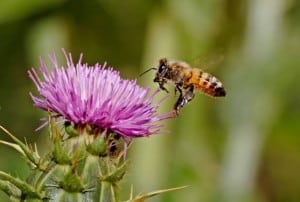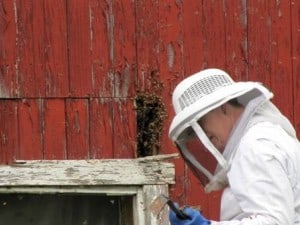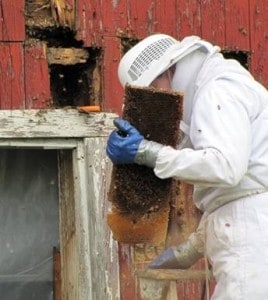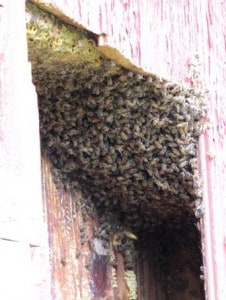Honeybees: A Brief Overview and the Bees at Rose Hill
By Alice Askins, Site Manager of Rose Hill Mansion
 A bee colony usually contains one queen bee, a fertile female; up to a few thousand drones, or fertile males; and a large population of sterile female worker bees. The workers are the ones we usually see, and they have varied roles in the hive. Eventually a worker goes outside the hive and spends the rest of her life as a forager.
A bee colony usually contains one queen bee, a fertile female; up to a few thousand drones, or fertile males; and a large population of sterile female worker bees. The workers are the ones we usually see, and they have varied roles in the hive. Eventually a worker goes outside the hive and spends the rest of her life as a forager.
Foragers cooperate to find food and use a pattern of “dancing” to communicate with each other about the direction of a food source and how far it is from the hive. In 1911 a bee keeper estimated that a quart of honey represented bees flying over 48,000 miles.
Honeybees establish new colonies by swarming. A mated queen and about 60% of the workers leave the hive. The group clusters temporarily in a nearby location, and sends out 20 – 50 scouts to find suitable nest sites. A scout returning to the cluster promotes a location she found by dancing to tell the other bees about its direction and distance. The more excited she is about her findings the more excitedly she dances. If she can convince other scouts to check out the location she found, they may go to look at the site and join her in promoting it. Several sites may be promoted by different scouts at first, but after several hours (sometimes days,) of persuasion, a favorite location emerges. When all scouts agree on a site the cluster flies to it. Meanwhile in the original colony, the remaining bees have prepared for the change by raising a new queen.
People have managed honeybees for many millennia. We use them not just for honey, but for commercial pollination of crops and other plants. Their pollination services are worth billions of dollars. That is why Colony Collapse Disorder (CCD) is so alarming. Beekeepers have seen slow declines of stock for many years. In early 2007, North America experienced abnormally high die-offs (30–70%) of honeybee colonies, an unprecedented decline. We don’t know why this is happening, but most of the evidence suggests that CCD is caused by a combination of factors rather than a single pathogen or poison.
Inside the back wall of the barn at Rose Hill we have had a colony of honey bees. We think they were in there for years and may be descendants of the bees dislodged from the Rose Hill porch column in 1966. Though the bees have not been aggressive, we decided to find them a better place to live. The trouble was that while most bee keepers will collect bees that are swarming (out in the open looking for a new home) very few will actually open up a wall to take them out. Fortunately we found a bee keeper who will.
Tammy Fazzi of Dryden is dedicated to the well being of the species. She will take colonies from barns, silos, and anyplace else she can reach with scaffolding and ladders. On Wednesday May 8, Tammy and her assistant made the trek up to Rose Hill.
After removing the first couple of boards with a crowbar, Tammy began to collect the bees in her special vacuum. They were angrier than most bees she usually encounters. Although she was wearing protective gear, bees crawled down inside her gloves, then up inside her sleeves, and stung her arms. Some got up under her veil and stung her neck. She had to stop and put on duct tape. She said, incidentally, that when you have been stung many times, it does not hurt as much. She would know, but it is hard to imagine.
I was hovering well back, taking pictures with a zoom lens. Some of the bees came after me, and I decamped and hid in the carriage house for a while. This meant that I missed the moment when Tammy cut a rectangle out of the wall with a sawzall and exposed the honey combs.
She took the combs out of the wall. Some of them were very old and she discarded them. Our hive had an unusually high proportion of comb containing drones, so she did not preserve all of that. There were a lot of queen cups, or cells where queen bees had developed; this indicates that many populations have left the barn over the years to make new hives. The combs she took were put into frames and the frames were placed into a box that holds them upright. If a section of comb is turned upside down, the larvae in it will die.
The removal process took about three hours. The bees settled down after their first fury, and I came back and took some more pictures. Tammy estimated that there were 55,000 to 60,000 of them, and they totally filled up her bee vac.
The wall will be left opened for a while. Tammy said that neighborhood bees will come and clean out the remnants of wax and honey, but they will not try to make another hive because the space is open. She also said any bees that escaped the round-up will find homes in other hives. It appears, though, that more bees than she anticipated were out and about while she was collecting, so now we are trying to find a beekeeper closer to us to come and take the orphans. Fingers crossed.



